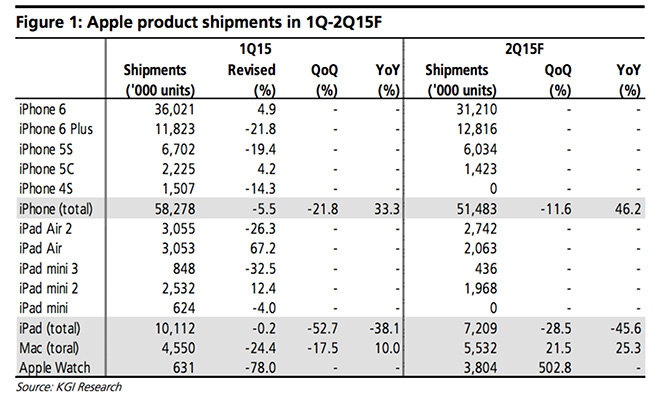After a gangbusters fiscal quarter one, Apple could see moderate gains highlighted by strong performances from iPhone and Mac over the three-month period ending March, according to noted KGI analyst Ming-Chi Kuo.
In a note obtained by AppleInsider on Saturday, the analyst is projecting iPhone, iPad, Mac shipments to come in at 58.2 million, 10.1 million and 4.5 million, respectively for Apple's second fiscal quarter of 2015. Apple Watch is also off to a good start at 631,000 initial shipments.
According to Kuo's assessment, Mac will be an area of substantial growth for the first half of 2015. For quarter two, he estimates shipments of 4.5 million units, a quarter-over-quarter decline of 17.5 percent, but back-to-school demand, the new 12-inch MacBook and a refreshed laptop lineup will drive 21.5 percent to 5.5 million units leading into fall.
On Apple Watch, Kuo feels it's too early to gauge the wearable's success. He estimates 631,000 initial shipments (curiously noted as 1Q15 shipments in the chart above), much lower than Street consensus, which anticipated Apple would push out 2-3 million units. Kuo blames supplier labor shortages and inadequate yield rates in production of key components like the haptic feedback vibrator and AMOLED display.
Further, the analyst believes Watch preorders have not yet saturated Apple's production capacity, based on output of 4.5 million units between March and June. Looking forward, Kuo projects shipments of 3.8 million units for the third quarter, once again lower than consensus, which stands at 5-10 million units.
Earlier this month, Kuo predicted Apple Watch preorders 2.3 million and production at 2-3 million units per month.
As for Apple's shrinking iPad lineup, Kuo expects that the touchscreen tablet will see a massive 52.7 percent sequential decline to just 10.1 million units. To put that in perspective, Apple sold 16.3 million iPads in the same quarter a year ago.
According to Kuo, Apple's "lackluster" iPad shipments for the March period will be largely due to "industry structural changes," rather than seasonal trends.
Finally, the analyst said that iPhone shipments have "peaked," though iPhone sales for each product cycle typically peak in the first full quarter. He expects that iPhone shipments will decline 21.8 percent sequentially to 58.2. million units, which would be yet another quarterly record for the company.
In the same quarter a year ago, Apple shipped 43.7 million iPhones. If Kuo's predictions prove accurate, Apple would increase its iPhone sales by nearly 15 million units year over year.
Apple is scheduled to reveal earnings for the second quarter of 2015 on April 27, with a conference call to follow at 2 p.m. Pacific. AppleInsider will provide live coverage of the event.
 AppleInsider Staff
AppleInsider Staff







-m.jpg)






 Charles Martin
Charles Martin

 Wesley Hilliard
Wesley Hilliard
 Stephen Silver
Stephen Silver
 William Gallagher
William Gallagher

 Marko Zivkovic
Marko Zivkovic
 Andrew Orr
Andrew Orr









128 Comments
Good to see Ming-Chi is about as pessimistic as it gets on Watch. And Apple doesn't have to report the numbers anyway so if they don't he can claim he is right. Brilliant plan. :rolleyes:
Someone help me out, how is Apple accruing watch sales in a quarter that finishes in March, when pre-orders weren't made available until April 10, and apple accrue earnings based on shipment, not order, placing the accrual dates even further from Apple's Q2. (I.e. their invoices are written out for when they charged your card, not when you placed the order.) Unless that note made by the analyst is referring to Q3 (April/May/Jun for Apple) just for the watch, for which half a million watch orders seems aggressively low based on consumer sales and interest studies and apple's historical fulfilment rate. (I.e. they wouldn't go to market only able to satisfy 7,000 production units per day in the quarter (an insanely low figure for apple.)
Good to see Ming-Chi is about as pessimistic as it gets on Watch. And Apple doesn't have to report the numbers anyway so if they don't he can claim he is right. Brilliant plan.
He's not saying people won't like it though, he's just saying Apple will be production constrained. And production line people seem to be where he gets his info from, so maybe he knows something WS doesn't in this case.
Whoever believes that a 52.7% decline from 16.3 million is equal to 10.1 million is mathematically illiterate.
What is "breaking" about this?